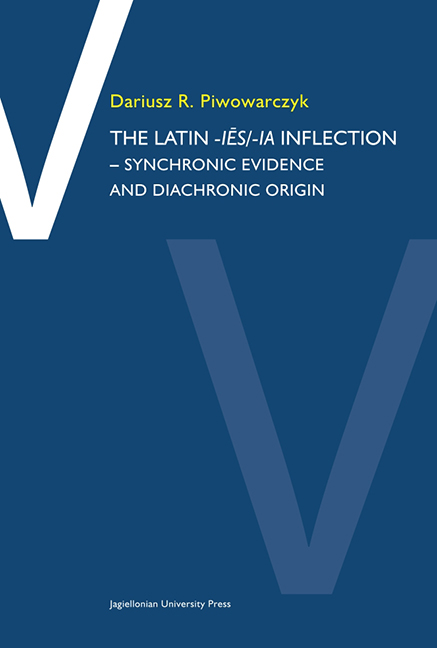Chapter four - The origin
Published online by Cambridge University Press: 16 July 2022
Summary
In what follows I will try to present a coherent theory on the origin of this type of inflection building especially on the earlier hypotheses put forward by Osthoff (1884: 338), Klingenschmitt (1992: 127-135) and, most of all, Nussbaum (1999).
It seems that the Latin fifth declension iēs/-ia inflection consists of several different formations which can be traced back to the proto-language:
a) the devī-́ type abstract formations to inherited Caland roots: e.g. aciēs (*h2eḱ-ih2), maciēs (*maḱ-ih2) with comparative counterparts in Greek akrós (*h22eḱ-ro-), makrós (*maḱ-ro-) (cf. Weiss 1993: 140, Nussbaum 1999, Rau 2009: 74),
b) vr̥kīḥ-type formations with genitival semantics: e.g. māteriēs ‘wood, timber, matter’ derived from māter ‘trunk of the tree,’ saniēs ‘pus from wound, bloody matter’ from *h1sh2en-ih2 with the base form attested in Hittite išhan ‘blood’ <*h1sh2en (cf. Klingenschmitt 1992: 128, Nussbaum 1999),
c) simple deverbal abstracts in *-iiā-: e.g. seriēs ‘row’ derived from serere ‘to join’ with comparative counterparts in Greek penía ‘poverty’ derived from pénomai ‘to be poor,’ Hittite šariya (cf. Chantraine 1933: 81, CHD: 259),
d) compounded deverbal abstracts in *-iā-: e.g. effigiēs ‘image’ dervied from effingere ‘to fashion’ with comparative counterparts in Vedic -vidyā ‘knowledge,’ -yajyā ‘sacrifice’ (Wackernagel-Debrunner II.2.: 831ff.),
e) adjectival abstracts in *-iiā-: e.g. luxuriēs from *luxuro- with comparative counterparts in Greek sophía ‘skill, wisdom’ from sophós ‘skilled, wise’ (cf. Chantraine 1933: 82).
As to their origin – I would argue that the starting point for the creation of the -iēs type of abstracts was either an original nominative in -iēs and an accusative made to that analogically in iem or an original accusative in -iem which would be the basis for remodelling of the nominative. Since there is no actual evidence for a *-ie̯ h11 - nominal suffix (cf. the discussion of the theories of Pedersen 1926 and Schrijver 1991: 379-387 in Piwowarczyk 2016, 2017b) I would opt for an original -iem accusative to which an analogical -iēs nominative was created. The model for such an analogical reshaping would be clear – the inherited accusative diem was the basis of the new nominative in diēs (following Nussbaum 1999 and Osthoff 1884: 338 and contrary to Klingenschmitt's hypothesis with the analogical model being uolpem).
- Type
- Chapter
- Information
- The Latin -iés/ia Inflection , pp. 125 - 134Publisher: Jagiellonian University PressPrint publication year: 2022



